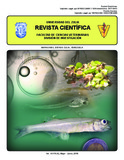| dc.rights.license | http://creativecommons.org/licenses/by-nc-sa/3.0/ve/ | es_VE |
| dc.contributor.author | Arrieta, Darwuin | |
| dc.contributor.author | Ascanio, Elías | |
| dc.contributor.author | Briceño, Elena del Carmen | |
| dc.contributor.author | Maniglia, Gema C. | |
| dc.contributor.author | Ascanio, Aouiqw Rafael | |
| dc.contributor.author | Flores Chona, Sergio A. | |
| dc.contributor.author | Mollero, Gladys | |
| dc.contributor.author | Pérez Arevalo, Maria L. | |
| dc.date.accessioned | 2018-06-19T21:21:45Z | |
| dc.date.available | 2018-06-19T21:21:45Z | |
| dc.date.issued | 2018 | |
| dc.identifier.issn | 0798-2259 | es_VE |
| dc.identifier.uri | http://www.saber.ula.ve/handle/123456789/44979 | |
| dc.description.abstract | El objetivo de esta investigación fue determinar los niveles de aflatoxinas totales (AFT) en alimentos balanceados para gallinas ponedoras y pollos de engorde, distribuidos en granjas avícolas de los estados Aragua, Carabobo, Lara y Zulia de Venezuela. Las muestras de alimento balanceado fueron tomadas de comederos de granjas seleccionadas y que permitieron su muestreo durante el periodo 2006-2007. Un total de 80 muestras de alimento fue obtenido de las granjas de gallinas ponedoras (n= 32) y de pollos de engorde (n= 48). Todas las muestras fueron pasadas por columnas de inmunoafinidad y luego a través de ELISA, usando los protocolos de RIDASCREEN ® para detección de AFT. Los niveles de AFT fueron contrastados con los establecidos por COVENIN, FAO/OMS, FDA y UE. Se detectaron valores de AFT en muestras (65 de un total de 80 granjas) distribuidos en granjas avícolas de Aragua, Carabobo, Lara y Zulia, encontrándose niveles de AFT en concentraciones menores y superiores a los niveles permitidos (20 μg/kg), establecidas por organizaciones nacionales (COVENIN) e internacionales (FAO/OMS y FDA). Los rangos detectados para granjas de ponedoras fueron: 0,3-156μg/ kg y para granjas de pollos 0,604-184μg/kg. No se detectó diferencia (P > 0,05) entre promedios detectados en granjas de pollos (48,72 μg/kg) y de ponedoras (41,83 μg/kg). Estos resultados de prevalencia en alimentos avícolas, indican que, posiblemente las aves de estas granjas muestreadas, recibieron alimentos con niveles de AFT mayores a los límites oficiales permitidos, durante el periodo evaluado. Es recomendable, mejorar la supervisión en los alimentos balanceados, destinados a la industria avícola nacional por las organizaciones responsables y considerar siempre la sensibilidad y coeficiente de variación de los métodos de detección sobre la interpretación de los resultados. | es_VE |
| dc.language.iso | es | es_VE |
| dc.publisher | Saber-ULA | es_VE |
| dc.rights | info:eu-repo/semantics/openAccess | es_VE |
| dc.subject | Aflatoxinas | es_VE |
| dc.subject | Pollos de engorde | es_VE |
| dc.subject | Ponedoras | es_VE |
| dc.subject | Avicultura | es_VE |
| dc.subject | Alimento balanceado | es_VE |
| dc.title | Niveles de aflatoxinas en alimentos balanceados para gallinas ponedoras y pollos de engorde, distribuidos en granjas avícolas de Venezuela (estados: Aragua, Carabobo, Lara y Zulia) | es_VE |
| dc.title.alternative | Aflatoxin levels in feed for laying hens and broiler in farms distributed in Venezuela (state: Aragua, Carabobo, Lara y Zulia) | es_VE |
| dc.type | info:eu-repo/semantics/other | es_VE |
| dc.description.abstract1 | The objective of this research was to determine the levels of Total Aflatoxins (TAF) in feed for laying hens and broiler in farms distributed in the States of Aragua, Carabobo, Lara and Zulia in Venezuela. Balanced food samples were taken from farm feedlots, which authorized its sampling during 2006-2007. A total of 80 food samples were obtained from laying hen farms (n = 32) and broilers (n = 48). All samples were passes through the immunoafinity column and then through ELISA using RIDASCREEN ® protocols for TAF. TAF levels were compared with those established by FAO/OMS, FDA, E.U. and COVENIN. Averages were compared between laying hens and broilers farms. The levels of TAF in analyzed samples, presented smaller (<20 μg/kg) and greater (>20 μg/kg) concentrations at the level allowed, established by organizations national (COVENIN, 1980) and international (the FAO/OMS and FDA). Detection ranges for laying hens farms were: 0.3-156μg/kg and 0.604-184μg/kg for broiler farms. The statistical differences were not detected (P ≥ 0.05) at average values in farms of broiler (48.72 μg/kg) and laying hens (41.83 μg/kg). These results indicated that laying hens and broiler from these farms, received food with levels of aflatoxins higher to the limits allowed during the season study. The results suggest, to improve the supervision in the balanced foods, destined to the national poultry industry by the organizations responsible and always consider the sensitivity and coefficient of variation of detection methods on the interpretation of results. | es_VE |
| dc.description.colacion | 180-191 | es_VE |
| dc.description.email | darwuin@yahoo.com | es_VE |
| dc.description.email | gemamaniglia@hotmail.com | es_VE |
| dc.identifier.depositolegal | pp199102ZU46 | |
| dc.identifier.edepositolegal | ppi201502ZU4665 | |
| dc.identifier.eissn | 2477-944X | |
| dc.publisher.pais | Venezuela | es_VE |
| dc.subject.institucion | Universidad del Zulia (LUZ) | es_VE |
| dc.subject.institucion | Universidad de Los Andes (ULA) | es_VE |
| dc.subject.keywords | Aflatoxin | es_VE |
| dc.subject.keywords | Farms | es_VE |
| dc.subject.keywords | Broiler | es_VE |
| dc.subject.keywords | Layers | es_VE |
| dc.subject.keywords | Poultry | es_VE |
| dc.subject.keywords | Balaced feed | es_VE |
| dc.subject.publicacionelectronica | Revista Científica | |
| dc.subject.seccion | Revista Científica: Artículos | es_VE |
| dc.subject.thematiccategory | Medio Ambiente | es_VE |
| dc.subject.tipo | Revistas | es_VE |
| dc.type.media | Texto | es_VE |


